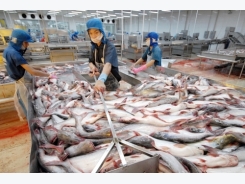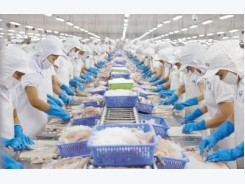Businesses optimistic over US inspection of Vietnams tra fish

Catching fish in Vinh Long province. (Photo: Quoc Dung)
NDO – The US Department of Agriculture (USDA) has decided to check all shipments of catfish and tra fish imported from Vietnam as of August 2, however, according to domestic tra fish exporters, this also presents an opportunity for the industry.
In light of the USDA’s decision, many tra fish exporters are hesitant and there have been comments that the route for Vietnam’s tra fish to enter the US has now been closed under the new catfish inspection programme (fish species under the Siluriformes group).
Bien Dong Company Limited is one of the few Vietnamese enterprises enjoying low anti-dumping duties in the US. However, following the move that requires tra fish entering the US to be checked in full, at inventories controlled by the USDA (known as i-houses), Ngo Quang Truong, director of Bien Dong, expressed his concern regarding the possibility of shipment congestion, thus leading to the delay of delivery. The possibility that the US market will be temporarily lacking in tra fish products is highly probable, while the company would struggle to make a capital return.
According to USDA's announcement, there are only 40 i-house warehouses scattered throughout the US, while 100% of Vietnam's goods arriving in the US have to be stocked through this system. The i-house’s will conduct an inspection of all catfish products imported from abroad to ensure that the quality of the interior matches that described on the external stickers. After that, standard products will be labelled with regulation conformity before being sold to the market.
However, Bien Dong Company’s director also stated that the inspection of catfish products by the US must not violate international practice; it is only a macro protection barrier to protect the American catfish sector. According to Truong, if domestic enterprises want to export steadily into the US market, they must, at least temporarily, comply with the host’s regulations.
Truong also revealed that the price of tra fish in the US has increased dramatically, to US$1.9 per pound (equivalent to US$4 per kg). "This is a great opportunity for Vietnamese businesses to export tra fish to the US," he affirmed, adding that thanks to this opportunity, export turnover of tra fish would be higher and is therefore good for both farmers and businesses.
However, there is also a challenge posed in the process of farming, as farmers and businesses must have a higher and more hygienic level of production with limited use of antibiotics and banned substances, towards developing an ecological model to overcome this barrier, Truong said.
He noted that the US is the leading market for tra fish from Vietnam and with the products entering this market fetching high prices, tra fish products in other markets will also have increased prices.

Processing tra fish for export at Hung Vuong JSC, My Tho Industrial Zone (Tien Giang province). (Photo: Quang Tuan)
As far as State management is concerned, the Ministry of Agriculture and Rural Development must play a key role in supporting domestic enterprises in dealing with such barriers, in which appropriate management and control must be applied. The requirement now is to comply with international rules to prove that Vietnam catfish is similar to US catfish, in turn resulting in Vietnamese products enjoying higher prices. In addition, when being positively viewed by the market, the value of tra fish will be raised.
Duong Nghia Quoc, Chairman of the Vietnam Pangasius Association (VINAPA), said that after August 2, Vietnamese tra fish entering the US will have a longer stockpile period than before.
The inspection is conducted very strictly and is a barrier for Vietnamese tra fish to export to the US. As specified in the contracts, the cost during this stockpile period is incurred by the import side. Therefore, according to forecast by enterprises, the import price of tra fish will increase which will affect the export volume of Vietnamese tra fish to the US.
To export catfish to the US, 100% of the products must not use banned substances during the farming process. The farming density must be ensured with prescribed regulations and the aquaculture area must be active in water sources not containing pesticide residues.
A representative from a tra fish processing business in Can Tho revealed that the business has linked with farmers in order to ensure quality and the company had to invest in machinery to control antibiotic residues and test product quality during the semi-finished to finished period.
The VINAPA chairman predicted that from now until the end of the year, the export of tra fish to the US may decrease because it takes a longer storage time than before. Meanwhile, consumers in the US could limit the consumption of tra fish products from Vietnam because of high prices due to rising costs.
According to a report from VINAPA, in the first six months of 2017, Vietnam tra fish exports reached US$836 million, up 5.8% over the same period last year. In particular, exports to the US reached nearly US$176.5 million, down 5.7% over the same period last year. The two biggest increases were China (up 46.5%) and Brazil (up 46.3%).
Có thể bạn quan tâm
Phần mềm

Phối trộn thức ăn chăn nuôi

Pha dung dịch thủy canh

Định mức cho tôm ăn

Phối trộn phân bón NPK

Xác định tỷ lệ tôm sống

Chuyển đổi đơn vị phân bón

Xác định công suất sục khí

Chuyển đổi đơn vị tôm

Tính diện tích nhà kính

Tính thể tích ao hồ




 Seafood exporters set for good year
Seafood exporters set for good year  Strong marketing strategy needed to bolster tra fish…
Strong marketing strategy needed to bolster tra fish…